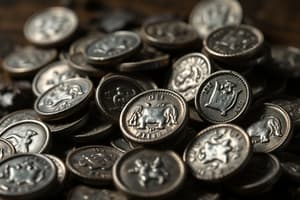Podcast
Questions and Answers
What broader historical context is essential for understanding the significance of the Chew Valley Hoard?
What broader historical context is essential for understanding the significance of the Chew Valley Hoard?
- The religious reforms enacted during the 11th century that altered monetary practices.
- The transition of power in England following the Norman Conquest in 1066. (correct)
- The Viking raids along the English coastline that led to widespread coin hoarding.
- The economic policies of William I aimed at consolidating royal power through currency control.
Considering Amal Khreisheh’s statement, what scenario most likely explains why the Chew Valley Hoard was buried?
Considering Amal Khreisheh’s statement, what scenario most likely explains why the Chew Valley Hoard was buried?
- An individual fearing the imminent conflict between Harold's sons and William I's forces. (correct)
- A wealthy merchant seeking to safeguard his assets during a period of economic instability.
- A religious institution attempting to conceal its wealth from the conquering Normans.
- A local lord preparing to fund a rebellion against William I's regime.
How does understanding the practice of cutting coins in half enhance our interpretation of the Chew Valley Hoard's economic role?
How does understanding the practice of cutting coins in half enhance our interpretation of the Chew Valley Hoard's economic role?
- It indicates a shortage of precious metals, necessitating the division of coins to meet transaction demands.
- It reveals the deliberate attempt to devalue currency by reducing the weight and purity of coins in circulation.
- It suggests the existence of a parallel, unregulated economy operating outside the purview of royal authorities.
- It demonstrates the adaptability of the monetary system to facilitate smaller transactions in the local economy. (correct)
What critical inference can be made from the hoard containing coins minted in 46 different locations?
What critical inference can be made from the hoard containing coins minted in 46 different locations?
What is the most significant implication of the Chew Valley Hoard's discovery for numismatic research?
What is the most significant implication of the Chew Valley Hoard's discovery for numismatic research?
Considering the division of the hoard's value, what does this reveal about British treasure laws and their impact on archaeological discoveries?
Considering the division of the hoard's value, what does this reveal about British treasure laws and their impact on archaeological discoveries?
Based on Gareth Williams' estimation, what does the comparison of the Chew Valley Hoard's value to '500 sheep or the annual income of a large estate' suggest about the economic structure of 11th-century England?
Based on Gareth Williams' estimation, what does the comparison of the Chew Valley Hoard's value to '500 sheep or the annual income of a large estate' suggest about the economic structure of 11th-century England?
If a similar hoard were discovered today, what factors would most significantly influence its monetary value beyond the silver content?
If a similar hoard were discovered today, what factors would most significantly influence its monetary value beyond the silver content?
How might the discovery of the Chew Valley Hoard reshape narratives regarding William the Conqueror's immediate impact on the English economy?
How might the discovery of the Chew Valley Hoard reshape narratives regarding William the Conqueror's immediate impact on the English economy?
Considering competing interests, what ethical considerations arise in the context of archaeological finds like the Chew Valley Hoard?
Considering competing interests, what ethical considerations arise in the context of archaeological finds like the Chew Valley Hoard?
Flashcards
Chew Valley Hoard
Chew Valley Hoard
A collection of 2,584 silver pennies dating back to the 11th century, discovered in Chew Valley, Somerset, England.
1066
1066
The year of the Norman Conquest, marking a major shift in English history.
King Harold II
King Harold II
The last Anglo-Saxon king of England, who died in 1066.
William I
William I
Signup and view all the flashcards
Cut Coins
Cut Coins
Signup and view all the flashcards
Safekeeping
Safekeeping
Signup and view all the flashcards
Study Notes
- In January 2019, Adam Staples and his friends discovered a hoard of silver coins in Chew Valley, Somerset, England, using a metal detector.
- The find, known as the Chew Valley Hoard, consists of 2,584 silver pennies.
- The coins date back to the 11th century, specifically from 1066 to 1068.
- On October 23, 2024, the South West Heritage Trust acquired the Chew Valley Hoard for $5.5 million.
- This acquisition is considered Britain's most valuable treasure find.
- Staples and his friends will receive half of the $5.5 million, approximately $400,000 each and the landowner receives the other half.
Historical Significance
- The coins were minted at 46 different locations in England.
- The hoard represents a turning point in English history with the Norman Conquest of 1066.
- The Norman Conquest marked the death of King Harold II and the rise of William I.
- Roughly half the coins feature King Harold II, and the other half feature William I.
- Historians suggest the coins were buried for safekeeping due to rebellions against William in 1068.
- Harold's sons launched attacks along the River Avon into Somerset after being exiled in Ireland.
Coin Characteristics and Value
- Some coins are cut in half, a common practice to create smaller denominations.
- The Chew Valley Hoard was worth about 500 sheep or the annual income of a large estate.
Display
- The Chew Valley Hoard will be displayed in museums across the UK, starting at the British Museum in London during November 2024.
- Afterward, the coins will be permanently housed at the South West Museum of Somerset.
Studying That Suits You
Use AI to generate personalized quizzes and flashcards to suit your learning preferences.





